Sierra Streams Institute’s rural health program conducts community based participatory research to expand our understanding of how living in a mining impacted environment affects the health of the people present in these communities.

At Sierra Streams, we are learning about the potential risks to our community’s health from mining, and how to mitigate those risks. While we partner with public and private institutions, our most important partner is you – the members of our community. All of our Rural Health projects are guided by, and carried out with and for the benefit of community members. Your questions, feedback and involvement are critical to this work.
Featured Projects
Tapwater Analysis Project (TAP)
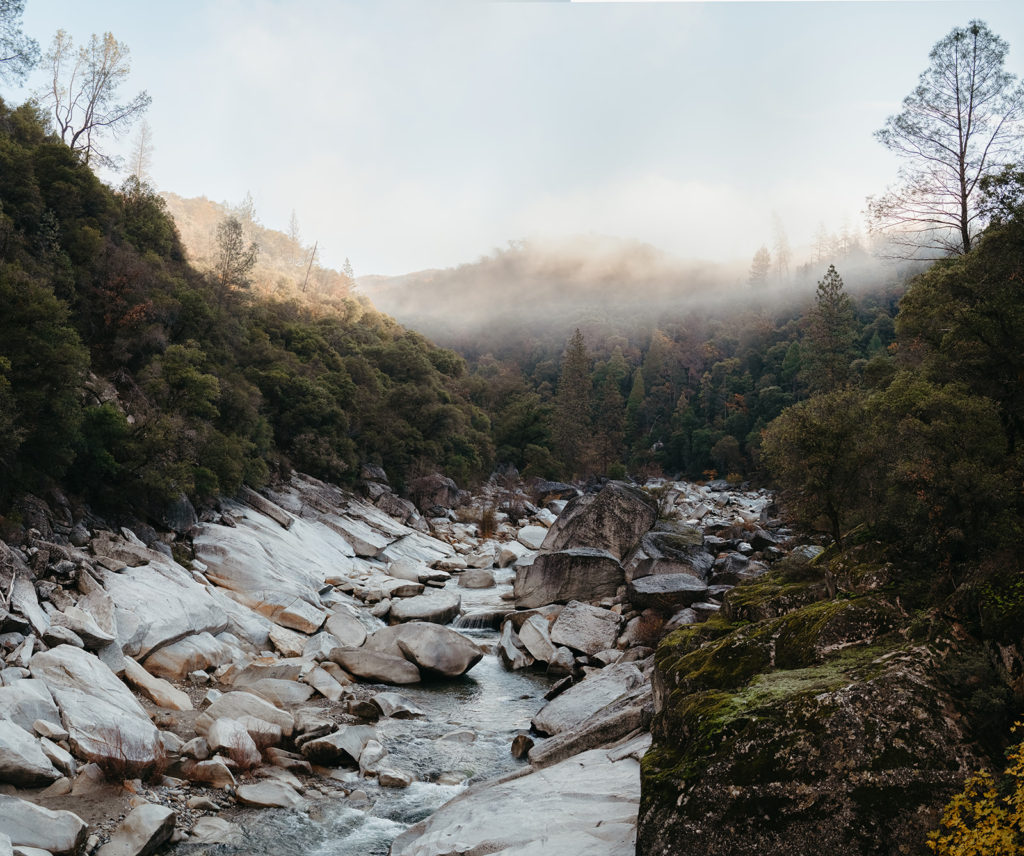
The Tapwater Analysis Project (TAP) is funded by the California Breast Cancer Research Program to investigate California’s drinking water for contaminants that may be associated with breast cancer. The goal of the study is to collect and test samples from water systems in four areas of California: Gold Country, the Central Valley, Southeast Los Angeles, and the San Francisco Bay Area. TAP is a collaborative project with Public Health Institute, Tracking California, USGS, USEPA, and Communities for a Better Environment. Sierra Streams Institute was a community partner in the Gold Country region for sampling.
Learn more about TAP
Where were the samples collected
We tested in areas with elevated breast cancer rates, where contaminants were known or suspected to occur, and in low-income areas.
Water samples were collected from participants in nine counties: Contra Costa, Fresno, Kern, Los Angeles, Madera, Merced, Nevada, San Mateo and Santa Clara.
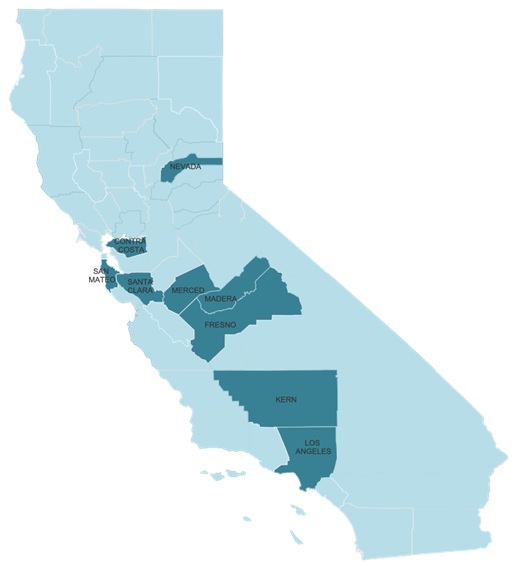
How were the water samples collected and tested?
Water samples were collected from homes where residents agreed to participate. Filter samples were also collected from most of these homes. Testing was at no cost to the participants.
- Water samples were sent to U.S. Geological Survey laboratories to test for minerals, metals, pesticides, disinfection byproducts and other chemicals.
- Filters were sent to a laboratory at the U.S. Environmental Protection Agency to test for hundreds of pesticides and other non-targeted chemicals.
- Samples of water are also being tested at the National Cancer Institute to see if unknown substances in the water could mimic or interfere with natural hormones.
What are we testing the water for?
We tested for many potential contaminants, including:
- Disinfection byproducts: These are formed when water is treated with chemicals (e.g., chlorine, chloramine) to kill bacteria, viruses, or parasites that can cause vomiting or diarrhea.
- Inorganics: These include metals, minerals and salts. Some inorganics occur naturally in drinking water, while others end up in the water due to human activity.
- Pesticides: These are applied to farmland, gardens and lawns, and can make their way into drinking water supplies.
- Hormone activity: Some chemical substances in water may behave like hormones in our bodies. Hormones are chemicals – such as estrogen, testosterone, and thyroid hormone – that help our bodies regulate metabolism, growth, development, reproduction, and more. We did not test for specific chemicals but instead measured overall hormone activity in the water sample.
- Pharmaceuticals: These can enter wastewater and contaminate drinking water supplies.
- Per- and polyfluoroalkyl substances (PFAS): These are a group of human-made chemicals that are used in manufacturing and consumer products. They may enter water from mulitple sources.
- Non-targeted testing: Non-targeted testing means that we try to identify any chemical that is in a sample. We tested filter samples collected from households that were able to install and submit filters. The carbon filters can retain many hundreds of chemicals.
- We are not testing for: Bacteria, viruses, and parasites, radiation, and volatile organic compounds (such as degreasing solvents and chemicals in gasoline). Our testing cannot guarantee that your water is free of those contaminants.
About Drinking Water
Where does drinking water come from?
Drinking water may come from aquifers (groundwater) or from lakes, reservoirs, or rivers (surface water). This water may be filtered and/or disinfected to increase public safety.
- California has nearly 3,000 community water systems that serve drinking water to 97% of the population of the state
- Community water systems may be operated by public utilities or by private water companies. All water system operators are responsible for serving drinking water that meets legal standards established by the federal and state governments.
- An additional 2 million Californians rely on private water supplies, usually a private well, serving less than 25 people. There are no legal requirements for private water supplies.
What can effect drinking water quality?
Many things can affect the quality of drinking water. Some examples include:
- Local geology influences levels of minerals and salts in water. Some minerals or salts are not harmful, but can affect the taste or color of the water. Others are toxic, such as arsenic and uranium.
- Nitrogen from fertilizers, animal manure or septic systems can contaminate groundwater.
- Lead, copper and other contaminants can leach out of pipes.
What do water systems test for and how often?
Community water systems are required to test for regulated contaminants, including harmful microbes (such as bacteria), minerals and chemicals. Sometimes the government requires water systems to test for certain unregulated contaminants that are under investigation.
The requirements for testing depend on:
- The size of the water system (how many households are served).
- Whether the contaminant was detected in previous testing and at what concentrations.
- Other characteristics (such as whether the system uses groundwater or surface water).
Some contaminants are tested quarterly, especially in systems with a history of violations or in large systems. Most contaminants are tested once per year. In small water systems without a history of contamination, testing may be done every three years.
How is drinking water quality regulated?
Setting drinking water standards
Drinking water standards are set by the U.S. government (U.S. Environmental Protection Agency) and by California (Water Resources Control Board, CalEPA).
In California, about 92 substances (chemicals and harmful microbes) have legally enforceable drinking water standards.
The California standards are either the same or stricter (more health-protective) than the federal standards.
Not all standards are enforceable
Enforceable water standards are called Maximum Contaminant Levels (MCLs). Regulated chemicals are not allowed in drinking water at levels higher than the MCL.
By law, MCLs are supposed to protect public health, while also considering cost and technical feasibility (such as the technical ability to detect or remove a contaminant to a health-protective level).
What happens if there’s a violation
If a water system violates a MCL, it is required to inform customers* and take action to address the problem.
Depending on the severity of the problem, the system may or may not be required to provide an alternative drinking-water supply such as bottled water.
Most water systems do not have any violations of MCLs, but a few systems have repeated violations.
*A “customer” is the person paying the water bill. If you do not directly pay your water bill, then you may not be getting informed if there is an MCL violation.
Maximum Contaminant Level Goals (MCLGs) and Public Health Goals (PHGs)
The federal government sets Maximum Contaminant Level Goals (MCLGs) and California sets Public Health Goals (PHGs) for chemicals that can harm health. These are levels at which no significant health effects would be expected over a lifetime drinking the water. MCLGs and PHGs consider the health effects on even the most sensitive populations. They are sometimes lower than the MCLs, which consider costs and technical feasibility.
Secondary Maximum Contaminant Levels (SMCLs)
Secondary Maximum Contaminant Levels (SMCLs) exist for about 15 contaminants such as iron and manganese that cause unpleasant odors, taste, or color in the water. Chemicals are generally not allowed in California drinking water at levels higher than the SMCL; however water systems may apply for a waiver under certain circumstances.
Notification Levels (NLs) and Response Levels (RLs)
Notification Levels (NLs) and Response Levels (RLs) are established for some chemicals that are not yet regulated. Water systems that exceed NLs must inform the state regulatory agency, but are usually not required to inform consumers. RLs are usually higher than NLs and are the level at which water systems are recommended (but not required) to take protective action. Actions could include shutting off a well, using treatment, or blending the water to bring the level of the contaminant below the RL.
Drinking Water in Your Area
Where can I find out about my water quality?
By law, a community water system must provide customers (those who pay a water bill) with an annual report, called a “Consumer Confidence Report” or “Water Quality Report”.
This report:
- Contains results of testing of the water, including any contaminants that were found and any violations that occurred.
- Contains information about where your drinking water comes from.
- Typically arrives with your water bill by July with results from the previous year.
If you do not pay a water bill directly or you don’t receive the report, you can contact your water supplier or look for the water quality report on their website.
Well owners are responsible for testing water from a private well.
What are common drinking water contaminants?
Water systems are required to check for some contaminants in each of the categories listed below.
In this study, we tested for some inorganic contaminants, disinfection byproducts, pesticides, and organic contaminants. Microbial contaminants, radioactive contaminants, and volatile organic compounds (VOCs) – a type of organic chemical contaminant – were not included in our study.
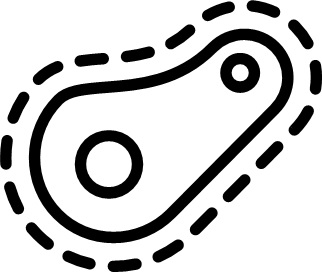
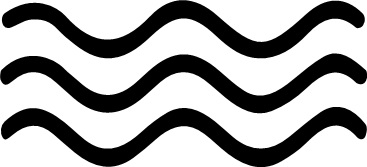



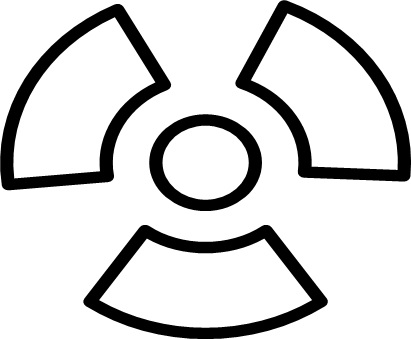
Microbial Contaminants, such as viruses, parasites and bacteria. These may come from sewage treatment plants, septic systems, livestock operations, and wildlife. These contaminants can occur anywhere in the state, in either surface water or groundwater.
Disinfection byproducts, such as chloroform and other chemicals produced by chlorination of drinking water. These are unintended consequences of treatment to eliminate microbial contaminants. They are mostly a concern in surface water systems.
Inorganic Contaminants, such as nitrate, salts and metals. Some of these occur from both natural and man-made sources. Man-made sources include stormwater runoff (from land), wastewater (sewage or waste from residential and industrial sources), oil and gas production, mining, industrial pollution, or farming. Lead and copper can leach from water pipes.
Pesticides. These may come from a variety of sources such as agriculture, golf courses, stormwater runoff, and residential uses.
Other Organic Chemical Contaminants. These may include a wide variety of chemicals which are products or by-products of industrial processes and petroleum. They can also come from hazardous waste sites, leaking storage tanks, urban or industrial stormwater runoff, agricultural applications, and septic systems.
Radioactive Contaminants such as radium. These can occur naturally in groundwater, or they can be a result of oil and gas production and mining activities.
What you can do about drinking water contamination
What to do if water smells, tastes, or looks bad
Color
| Characteristic | What can cause this? | How can I remove this? |
| Brown/red/orange | •Iron •Manganese •Soil particles •Dissolved organic matter | •If it is intermittent, it may be from work on water mains. In this case, run the water to flush your pipes. •Use a water filter certified for iron or manganese. |
| Blue/green | •Copper – can indicate pipe corrosion from acidic water •Algae | •If the water is acidic, test for lead, which can also occur from pipe corrosion. •Use a water filter certified for copper. •Microfiltration can address algae, but test first for cyanotoxins. |
| White | •Air bubbles or precipitated solids •Calcium, magnesium, barium (may leave residues on dishes, toilets, sinks) Silica | •To check for air bubbles, pour water in a clear glass and wait to see if it clears up within 2-3 minutes. •If the cloudiness does not go away, it could be due to particles formed in heated water. Treat by flushing your water heater. Calcium, magnesium, barium and silica can be removed by a water filter certified for those chemicals |
Smell
| Fishy | •Barium or Cadmium •Chloramine •Algae | •Contact your water company for assistance. Use a certified water filter if you know what is causing the odor |
| Rotten egg or sewage | •Hydrogen sulfide, sulfides, sulfate reducing bacteria | •Use a water filter certified for sulfide. •Disinfect drains to remove odor. |
| Skunk or garlic | •Selenium | Use a water filter certified for selenium |
| Oil or gasoline | •Various substances including fuels, motor oil, cooking oil, or natural organic matter | •Rare, but can be serious. Do not use the water and contact your local water department. Test for total petroleum hydrocarbons (TPH) and volatile organic compounds (VOCs). |
Taste
| Salty | •Sodium, chloride, magnesium, bromine, or potassium •Iron, corrosion of metals | Use a water filter certified for these minerals |
| Bitter, medicinal Astringent | •Sulfate above the Secondary Maximum Contaminant Level (SMCL) | •Contact your water company. Use a water filter certified for sulfate |
| Metallic | •Lead •Arsenic •Iron, copper, zinc, manganese •Low pH | •Contact your local water company to ensure lead and arsenic are not the causes of metallic taste.· •Flush out your pipes before using the water for drinking or cooking and avoid using hot water. Consider a certified water filter. |
Why are some chemicals unregulated?
There are many thousands of chemicals and minerals that are found in the earth or used in products and industrial processes.
Most of them are not regulated, especially if they are not typically found in drinking water, or if there is not much information about their health effects.
- Unregulated chemicals are generally not tested for unless there is a growing concern. For example, California is now monitoring for 18 unregulated PFAS chemicals in some drinking water supplies as they consider how to regulate these chemicals.
- Unregulated chemicals may or may not be harmful to health.
- Sometimes there is not enough research yet for the government to set standards for a specific chemical.
- The federal and state processes to regulate additional chemicals is very lengthy.
If a chemical is not regulated in drinking water, it can sometimes be difficult to say if a certain level is safe or not.
Home water filters and other treatment options
| Filter Type | Granular Activated Carbon (GAC) Filter | Ion Exchange Filter | Distillation Filter | Reverse Osmosis (RO) Filter |
| How it works | As water passes through, most contaminants are absorbed onto the carbon and remain in the filter. There are two general types of GAC filters: Loose carbon and carbon block. Carbon block filters come in different pore sizes, which affect what they can effectively filter. | This filter users a chemical process to exchange or replace unwanted dissolved ions in water (such as nitrate, fluoride, sulfate, arsenic) for other ions (such as sodium or chloride) with a similar charge. These filters may be referred to as cation exchange (for positively charged ions) or anion exchange (for negatively charged ions). | Tap water is added to a chamber where boiling kills most bacteria and viruses. Boiling produces steam which rises and is cooled and converted back into a liquid. It is important to maintain these filters by draining the sediments that accumulate in the boiling chamber. | Water pressure pushes tap water through a membrane that stops most contaminants from passing through. Fresh water is produced and waste water (brine) is left over. Look for a filter that is certified under NSF/ANSI Standard 58. The filter may clog if there is no pre-filter, so these systems typically also include a GAC filter. |
| Effective against | Taste, odor, VOCs and disinfection byproducts. Many pesticides and industrial chemicals. Some PFAS. Carbon block filters remove sediments. Filters with a pore size of 1 micron or less can usually remove lead, iron, arsenic, bacteria and parasitic cysts. | Nitrate, metals, arsenic, other minerals, some PFAS | Heavy metals, dissolved solids, most bacteria, minerals such as nitrate, sodium, fluoride, and sulfate, Some toxic organic chemicals. | Dissolved solids (minerals, arsenic, etc.), nitrate, sulfates, fluoride, most VOCs, herbicides, many PFAS and pesticides. |
| Not effective against | Generally does not remove minerals, salts, and dissolved inorganic substances like nitrate. Some PFAS compounds are not effectively removed. | Bacteria, most organic chemicals | Most volatile and semi-volatile organic compounds, some bacteria | Viruses and dissolved gases. Bacteria can sometimes penetrate these filters if they are not well-maintained. |
| Other considerations | • If not replaced regularly, filters can saturate and can dump contaminants into water. • GAC filter pitcher or faucet system costs less than $40. Replacement filters are inexpensive. • Under-sink systems cost $100-200 and are relatively easy to install | • Countertop water filter with ceramic filter and ion exchange media costs about $100. • Whole building systems are expensive (normally $1000+). • Can be wasteful and costly to operate. They require multiple bags of salt, and a whole-home system can waste 150 gallons of water per week. | • Household/countertop water distillers usually cost $100 – $500. • Plumbing distillers can be installed into existing home plumbing. They distill water as you need it, making it a cost-efficient way to get the water distilled. These cost between $300 to $1000 and will produce water for about $0.25 a gallon. | • RO filters waste a lot of water. About 3 gallons of water is wasted for every 1 gallon filtered. • Under-the-counter RO systems can cost between $200 – $500 and replacement filters are expensive. • Whole house RO systems are typically used for treating a large volume of water (150-50,000 gallons). These cost between $1000 – $5,000. |
Community Health Impacts from Mining Exposure (CHIME)
CHIME is a series of studies examining the potential community health impacts of living in a mining impacted environment. The study focuses on legacy mining minerals and female breast cancer incidence rates in Nevada, Placer, El Dorado, Amador, Tuolumne and Yuba counties. CHIME is a partnership between Sierra Streams Institute, University of California San Francisco, and University of Arizona. This project is funded by state tobacco taxes through the California Breast Cancer Research Program.
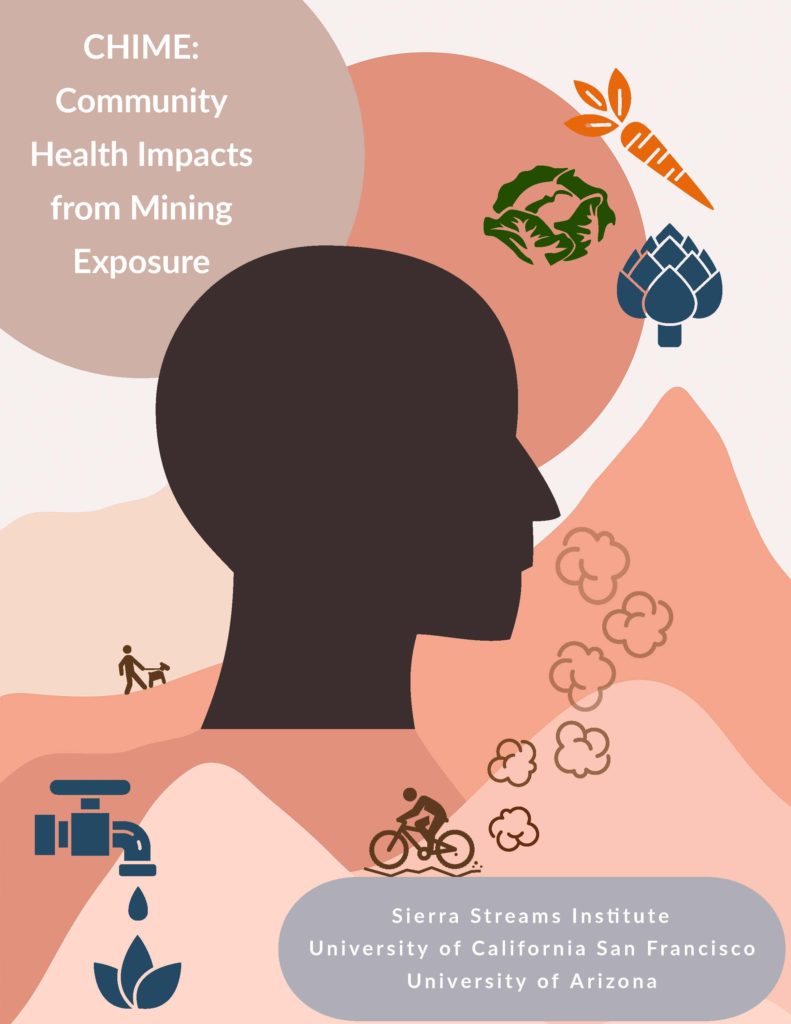
CHIME 3

Our current study, CHIME-3, builds off three previous pilot studies to provide the next chapter of this large toxicology study. While aiming to expand our community engagement, this study will focus on two main goals: (1) mapping residential proximity to mines and mining hazards for breast cancer cases throughout Gold Country using California Cancer Registry Data, and (2) Collecting additional information on household risk factors by sampling irrigation water, soil, dust, and homegrown vegetables. Additionally, we conducted an extensive questionnaire with each participant to find out information about their health history and recreational lifestyle. The questionnaire helps us assess other potential exposure risks the participants face in their daily lives.
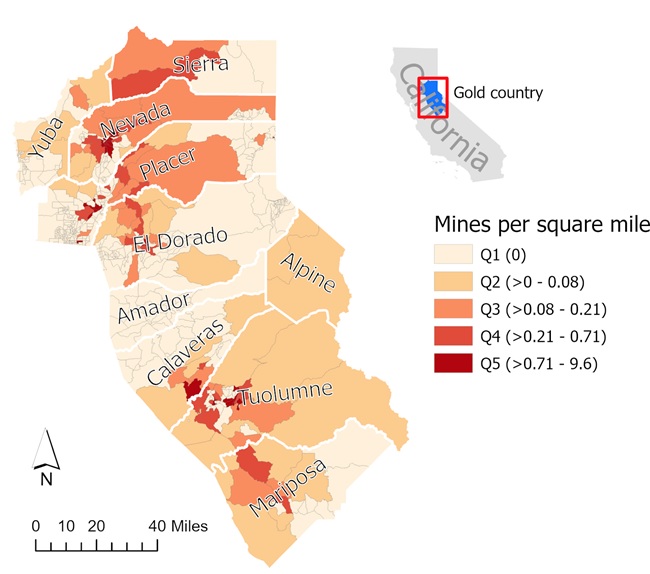
*Mine density was calculated using data from the Principal Areas of Mine Pollution dataset from the CA Department of Conservation, where mines of interest were those that mine(d) for Gold, Copper, or Chromium, and which did not include mine types to be of lower concern (e.g. quarry, gravel, and placer mines). Data are displayed as quintiles of selected mines per square mile by 2010 Census Block Group land area. Amador county does have minse but its data was not part of the PAMP dataset.
Publications
CHIME 3 Results – Select CHIME Gold Country CA to see results from CHIME 3
Gardenroots

This study focused on investigating potential heavy metal exposure for young children, since they are in a critical development period. In terms of exposures, children are a sensitive population and when living near contaminated sites, they receive the majority of their metal exposure through indirect ingestion of soil and dust due to hand-to-mouth transfers of contaminated media. For this reason, we chose to sample preschool gardens and playgrounds. We specifically sampled soil, dust, and vegetables grown in local gardens.
The results from this project showed elevated levels of lead in two of the sites. When one of the elevated sites was re-tested, it came back below the screening levels for lead. The school chose to remove the soils. We are hoping to get more funding to follow up and do more testing at more schools to have a larger sample size. Gardenroots results are best accessed at this website under the Nevada County, CA section: https://gardenroots.arizona.edu/community-status
From this project we distributed a manual for people to reference called “Gardenroots Best Practices” which is a guide to help people reduce their exposure to heavy metals when gardening and working closely with soils in this area.
Publications
CHIME 2
Our second pilot study, CHIME-2, was designed to follow-up on observations for Cd and As body burden elevations in local women. The main aims were to recruit women with a history of breast cancer to assess whether the levels of the study metals differed for body burden or for household samples and also to sample household media (soil, dust and tap water) to evaluate the degree to which the presence of As and Cd in homes might be associated with differences in body burden.
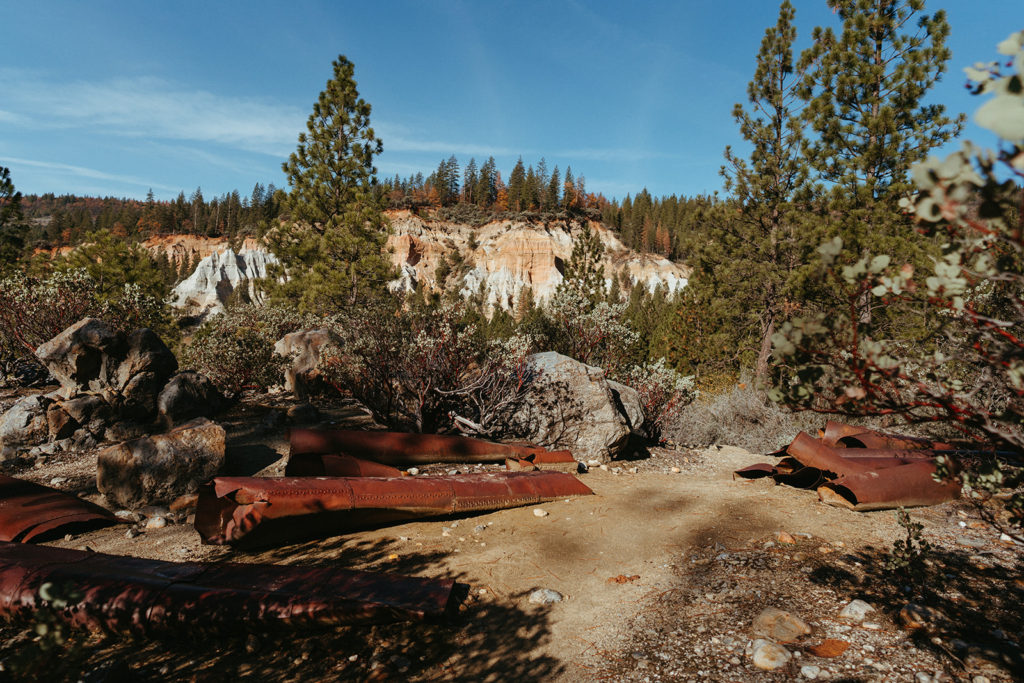
Results showed women with a history of breast cancer had higher body burden of Cd, but not As. There were no detections of Cd in any of the household samples, and only a few detections of As in dust and water samples. Arsenic was detected in 92% of the collected soil samples. And levels of As were higher in yard soil samples from women with a history of breast cancer.
Additionally, participants who reported frequent consumption of local garden produce and routinely hiking/running on local trails tended to have higher body burden of As. Although Arsenic in soil was generally not correlated with As in urine, there was a suggestion of such correlation among non-smoking women who reported frequent consumption of home-grown produce.
Despite a relatively small sample size these results suggest that a more careful assessment of lifestyle activities and breast cancer risk factors may be important for addressing the potential role of mining associated environmental contaminants and disease risk.
CHIME 1

Our first pilot study, CHIME-1, collected questionnaires and urine samples from 60 local women over the age of 18. The women participants were divided by age (under 35 and 35+) and then those two groups were divided again by length of residency in Gold Country. We had half of each age cohort as long-term residents (more than 10 years) and half recent arrivals (less than 10 years).
Urine samples were analyzed for a full panel of metals in addition to Cd and As. Results indicated that average body burden levels (which just means the total amount of chemical or metal present in the body) for most metals appeared consistent with reported levels for women in the National Health and Nutrition Examination Survey (NHANES). However, levels of total As in CHIME participants were significantly higher than average levels for similarly aged women in the NHANES. Overall, Cd levels were similar to the national average, except for women over 35 years who had lived in the region for 10+ years. Women who had lived in the region for 10+ years had elevated Cd levels.
Best Practices for Safer Gardening in Contaminated Areas
These tips for safer gardening practices in contaminated areas were generated under the project Gardenroots by Monica Ramirez- Andreotta, Department of Soil, Water and Environmental Science of the University of Arizona.
Garden Preparation: Ways to Reduce Arsenic Absorption by Vegetables
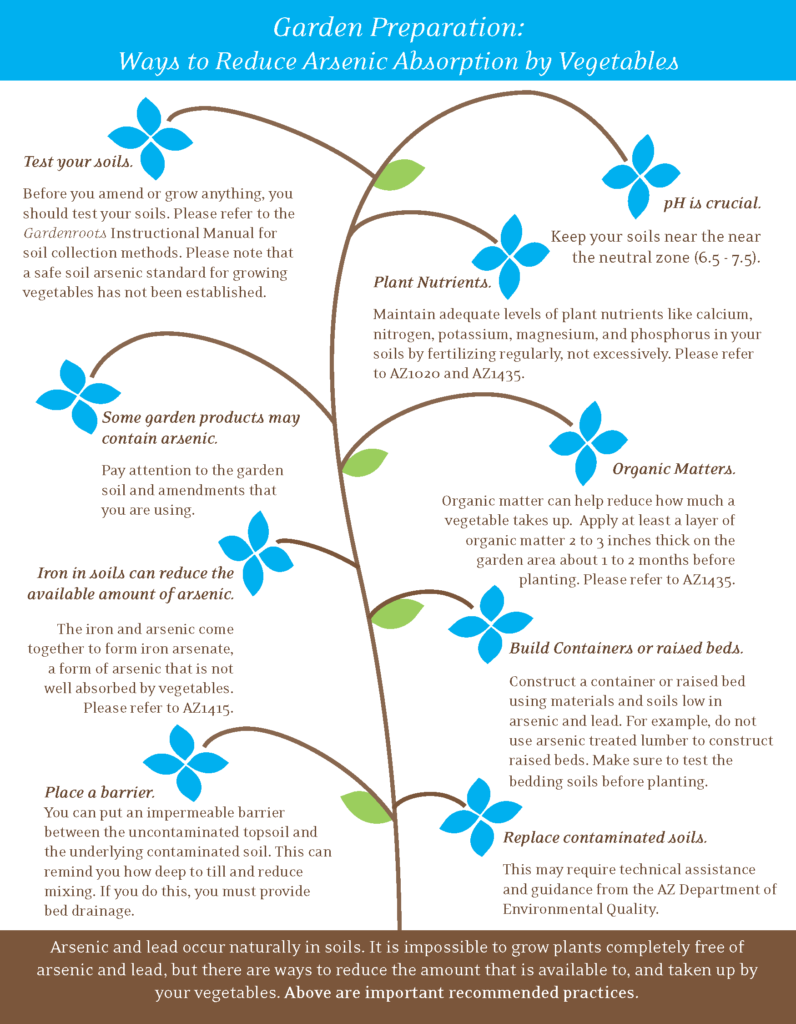
Safe Gardening: Ways to Reduce Inciedental Soil Ingestion and Inhalation

Safe Consumption of Homegrown Vegetables: Ways to Reduce Dietary Arsenic and Lead Ingestion


